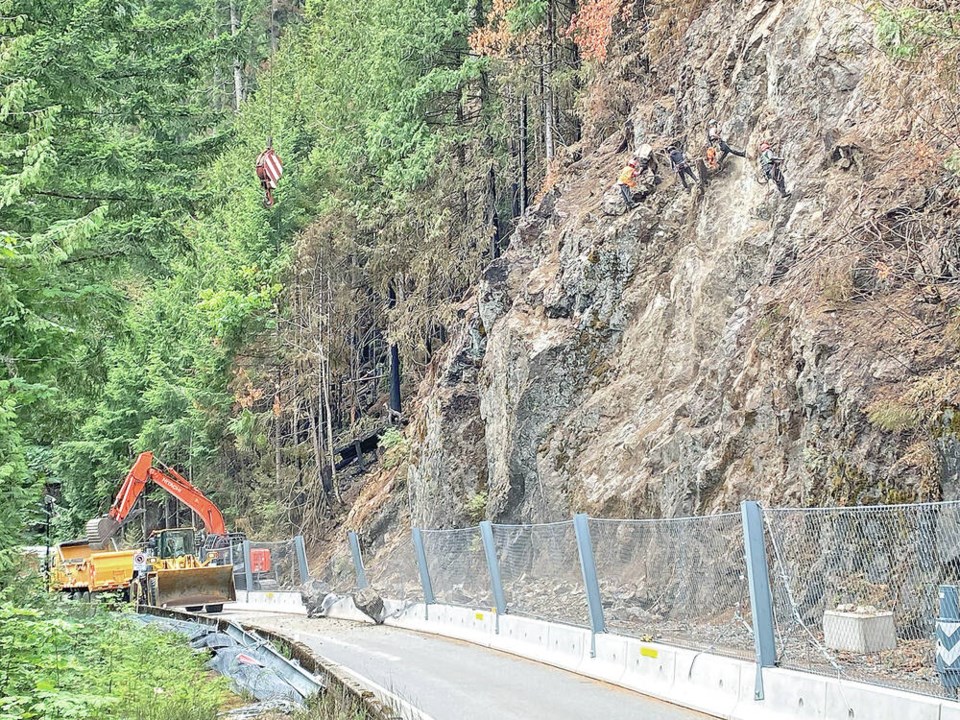The closure of Highway 4 on Wednesday, when rain compromised adjacent slopes, underscores recent talk about establishing an alternative route linking west coast communities to the rest of the Island.
The highway has been an issue for travellers and the passage of goods since June, when a wildfire at the Cameron Lake Bluffs led to its closing due to the danger posed by falling debris. That was followed by the creation of a detour route on forest and industrial roads between Port Alberni and Lake Cowichan, via the Bamfield area, but it is long and sometimes challenging for drivers.
The next step was opening a single highway lane to allow alternating traffic to get through. The lane has been subject to periodic closing to allow workers to do rock scaling — the removal of loose rocks — on the slopes affected by the fire.
The province has said it aims for a full reopening of Highway 4 around mid-month.
The Alberni Clayoquot Regional District made a move in late July by deciding to establish a transportation committee to look at another route, as well as other transportation issues.
Regional district board vice-chair Debbie Haggard, who is also a Port Alberni councillor, said Wednesday that transportation concerns “are very top-of-mind right now for everyone.”
She said the regional district had a similar committee several years ago that looked specifically at the Horne Lake Connector as a second route. The connector runs north from Port Alberni and around Horne Lake before intersecting with Highway 19 north of Qualicum.
It is narrow and not passable for all types of vehicles, but has been used at times by the B.C. Wildfire Service to reach certain locations.
Both the regional district and the province did studies that concluded the route wasn’t economically feasible at the time, Haggard said.
With the current situation on Highway 4, she said, the regional district has determined “that they need to bring the transportation committee back and re-look at the Horne Lake Connector or another alternate route.”
“It doesn’t necessarily have to be the Horne Lake Connector, but whatever is the best route and also the one that will be economically viable for the provincial government to do.”
A regional district report said that the committee’s work could take in transportation options that include an alternative route “in and out of the Alberni Valley, the Bamfield Road, the Bamfield/Cowichan route and route to the west coast.”
Part of the committee’s role will be to advocate to the province that steps need to be taken, Haggard said.
She said the existing detour route via the Bamfield area was “a good alternative” after the problems with Highway 4 emerged so quickly in the wake of the wildfire.
“But it’s not a long-term solution,” she said. “If you’re not familiar with that road, it’s not the best route to take.”
Haggard said it takes four hours to complete and is best-suited to four-wheel drives or pickup trucks, but it played a crucial role in getting supplies to west coast communities when the highway problems began. It was used by about 1,000 vehicles a day, then went down to 100 a day when the single-lane option was put in place on Highway 4.
Ucluelet Mayor Marilyn McEwen, also a board member, said she is behind the formation of the committee, as well.
“We’re not the only community that just has one road in and out, but it does really isolate us when things like [the Highway 4 closures] happen,” she said. “I hope the province does something to help us get a second route in.”
Jenny Brunn, the district’s general manager of community services, said the committee’s inaugural meeting is set for October, when a budget for its activities will be considered. She said the plan is to have three regional district directors involved, along with representatives from First Nations and chambers of commerce, the Ministry of Transportation and such businesses as Tsawak-qin Forestry, Mosaic Forest Management and Paper Excellence.
The Ministry of Transportation said in a statement that it will be pleased to be part of the regional district’s efforts to address its concerns.
“The ministry regularly works with local governments and Indigenous communities on transportation planning, including options for safest travel to keep goods, services and people moving in an area,” the statement said. “The recent wildfire along Highway 4 emphasized the importance of ensuring our highway network is resilient and reliable, both now and in the future.
“We know our highways and side roads are often the sole means of transport for rural and Indigenous communities, and we are always considering detour routes or other options for communities at risk of being cut off due to fires or natural disasters.”
The ministry’s work on Highway 4 has included projects such as the one that improved the area around Kennedy Hill, the statement said.
>>> To comment on this article, write a letter to the editor: [email protected]



